Analyzing Intel Core M Performance: How 5Y10 can beat 5Y71 & the OEMs' Dilemma
by Brett Howse & Ian Cutress on April 8, 2015 8:00 AM ESTClosing Thoughts
There is a lot to say about Core M performance. We have tested three very different devices, all with Core M inside - each device tackles the design philosophy of Core M from different directions, and it comes across in the results based on where each device stands. We started this analysis to answer the question "how can 5Y10 beat 5Y71?', and the results answer that quite clearly.
Dell Venue 11 Pro 7000 (5Y71)
Starting with the Dell Venue 11 Pro 7000, this is an 11 inch tablet with passive cooling and a small chassis. The plastic exterior helps with skin temperature, but hinders the ability of the device to radiate the heat that it generates.
This chart shows where Intel believes Core M can be done in a passivly cooled device, and it assumes a metal chassis which the Venue 11 Pro 7000 lacks. Device thickness, material, and chassis size all play a big factor in how much heat can be dissipated. Under sustained use, the Venue 11 Pro can get warm to the touch, but as seen in the previous pages the actual SoC temperature can spike very rapidly. This compromises performance, although everything is relative. Compromised Core M CPU performance is still quite a bit more powerful than a Silvermont core in an Atom.
Lenovo Yoga 3 Pro (5Y71)
The Yoga 3 Pro on the other hand is a convertible tablet, and is the only Core M device in our test with active cooling. Lenovo has gone to great lengths to ensure that it does not get hot in the hand, since it most certainly can and will be used when held. It has the lowest SoC temperature of any of the devices by quite a bit, although it is of course helped by the inclusion of a fan. Lenovo has clearly set a target SoC temperature of 65°C as the maximum they are comfortable with in order to keep skin temperatures where they want them. It does not really hurt the device in all workloads, and as we have seen the Yoga 3 Pro can even outperform a Core i5-5200U in cherry-picked scenarios. On sustained maximum performance though, the lower SoC temperature means that the CPU and GPU must cut back sooner than the other devices, which limits performance.
ASUS Zenbook UX305 (5Y10)
The ASUS Zenbook UX305 is a completely different device. It is a laptop, so skin temperatures are not as big of a concern, and while it does get hot at around 48°C on long workloads, that heat is well away from where you would normally be touching the device. Also, being made out of aluminum is clearly a huge benefit for a passively cooled device such as this, as it allowed the ASUS to consistently outperform the other Core M devices despite it being the lowest boost frequencies in the test. The performance of the Zenbook was very consistent, even on extended workloads, and on the DOTA 2 test, the Zenbook even outperformed the Latitude, although that was less to do with thermals and more to do with the lack of memory bandwidth on the Dell laptop.
Core M
So with all of this data, what more do we know about Core M? Clearly, Intel’s goal with Core M is to provide excellent performance on short workloads. It has higher boost frequencies than the Core i5-5200U that was included in this test, and it has 4 MB of L3 cache as well compared to 3 MB of cache on the i5. On certain workloads, performance can even surpass the i5-5200U. Race to sleep is not a new idea, but that is what Core M is designed to do, and it does it well. Run on very little power, and then when tasked with work, get it done as quickly as possible and get back to the low power mode. This is not unique to Core M of course, as the Core i5 does the exact same thing, however the much more restrictive thermal envelope of just a 4.5 watt TDP means that sustained workloads just have to suffer compared to a device with a 15 watt TDP.
We did see that happen too. The Core M scored very well in the PCMark 8 benchmarks, which attempt to emulate real world use rather than just performing a single task until it is done. The burst nature of this allowed Core M to have enough time in between work to keep the temperatures in check. On sustained work, this was not always the case.
On the 5Y71 vs. 5Y10 front, we have some clear lines drawn:
| Intel Core M Performance | |||
| 5Y10 Result ASUS UX305 |
5Y71 Result Lenovo Yoga 3 Pro |
5Y71 Result Dell Venue 11 Pro 7000 |
|
| Cinebench R15 ST | 82.14 pts | 90.85 pts | 86.00 pts |
| Cinebench R15 MT | 210.66 pts | 196.00 pts | 175.00 pts |
| PCMark 8 - Home | 2655 pts | 2443 pts | 2606 pts |
| PCMark 8 - Creative | 3056 pts | 3110 pts | 3064 pts |
| TouchXPRT 2014 | 654 pts | 820 pts | 764 pts |
| 3DMark Sky Diver | 2773 pts | 1624 pts | 1820 pts |
| 3DMark Cloud Gate | 4251 pts | 3685 pts | 3753 pts |
| 3DMark Ice Storm | 47527 pts | 49619 pts | 44911 pts |
| DOTA 2 | 34.0 fps | 26.5 fps | 25.2 fps |
It also shows just how much the individual device plays in how much performance is available. The ASUS has by far the best cooling solution of the three Core M devices, which is helped of course by the form factor. Lenovo could not get away with a 50°C surface temperature on a device that can be used as a tablet. It just would not work. The form factor of the Yoga 3 Pro plays against it on sustained workloads. The Dell Venue 11 Pro allowed a much higher SoC temperature, but it would also spike there very quickly. What we would really love to see is the Core M-5Y71 processor inside of the Zenbook to see just how much the increased boost of the 5Y71 compromises the performance on longer duration workloads, if it does.
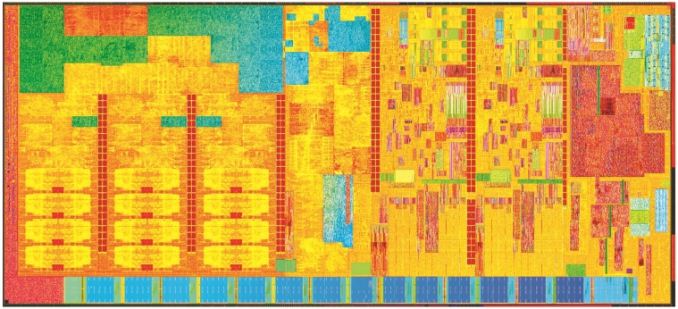
Die Shot of a Core M Processor
Is Core M a good processor? Or is it slow? It is clearly slower than a Core i5, but it would be hard to expect it not to be. On many daily workloads, it performs very well. On things like web browsing we are already to the point where the Yoga 3 Pro outscores a Core i7-860 4C/8T 95 watt desktop CPU from 2009 in web benchmarks. Since Core M is mainly aimed at thin and light devices, it can be expected that these are the kinds of workloads that one would perform on them. Many companies have jumped onboard with the smaller processor, as it allows a thinner and lighter device, and the possiblity of having no moving parts. Core M enables this with a much lower TDP than the next tier of mobile processors from Intel, as well as a smaller overall SoC which is thinner as well.
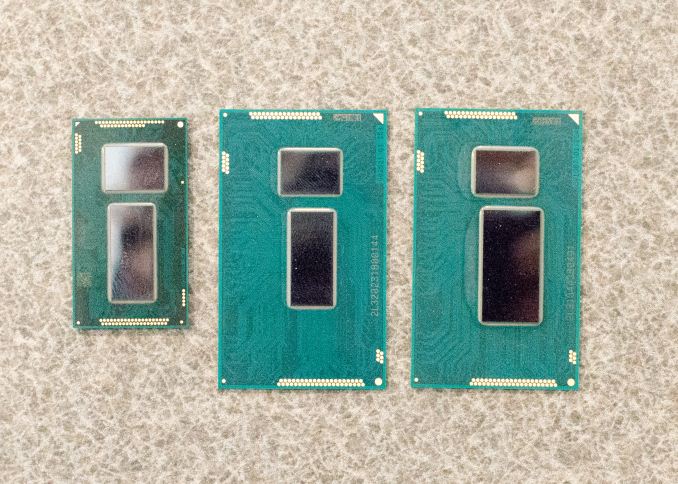 Broadwell-Y (left) vs Broadwell-U (center) vs Haswell-U (right)
Broadwell-Y (left) vs Broadwell-U (center) vs Haswell-U (right)
With the rise of tablets, the migration from hard desktops to smaller form factors has been unprecedented and Core M gives much more CPU performance than any tablet SoC available right now, at the expense of the additional cost the premium product brings. It is well suited to the types of workloads that many of us do during a typical day. There has been a lot of design wins already for this processor, covering a large range of device types and manufacturers. Even Apple has decided that there is a niche where a thinner and lighter version of their laptop may be of good use to their customers.
That said, there are a few other differences that set Core M apart from the mainline Core processors that need to be noted. For example, even though it shares the Gen8 Graphics with the Core i3 / i5 / i7 models in Broadwell-U, it is not quite as capable. It only has software HEVC decode for instance, which means that it might not be suitable for a Home Theatre PC without additional graphics helping out. Gaming is also a scenario where Core M can come up short, but only if you are comparing it to typical PC games. Tablet style games will have no issues, and Core M can perform similarily to other tablets in the GPU department.
In the end, we will quote one of Brett's favorite Formula 1 announcers and author, the great Steve Matchett. Everything is compromise. In Formula 1 racing, each corner of the track would need a different setup on the car for maximum results for that corner, and on the straights you would want most of the car’s downforce removed. Therefore every race and even every corner of a race is compromised for the maximum overall lap speed. The same can be said of Core M. In order to get something as powerful as the Core architecture inside of a fanless tablet, there is going to be compromise. In a Core M device, that is going to be sustained performance. What you give up in sustained performance though allows a thinner and lighter device, in form factors that would never have been possible with Core even one year ago. But it also means that the Core M SKU designation is only a sign of general performance, rather than absolute positioning. For that, we have to compare and contrast each unit in a review. Luckily, we hope to cover a large number of the important models over the next few months.



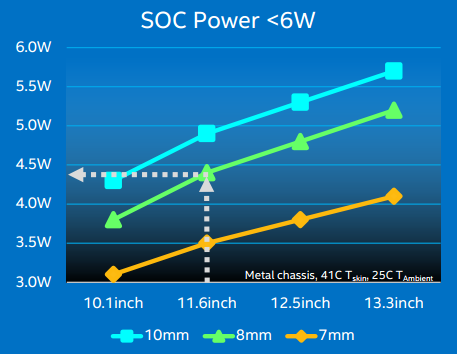
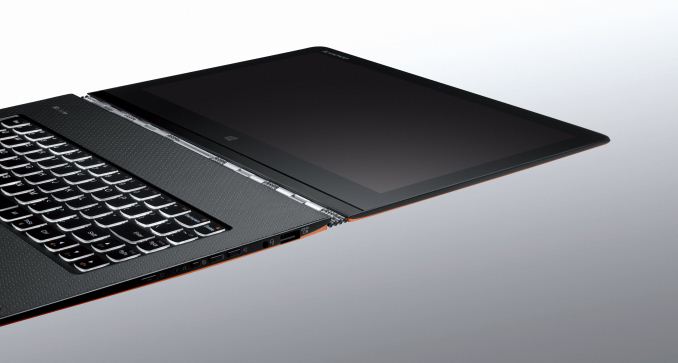
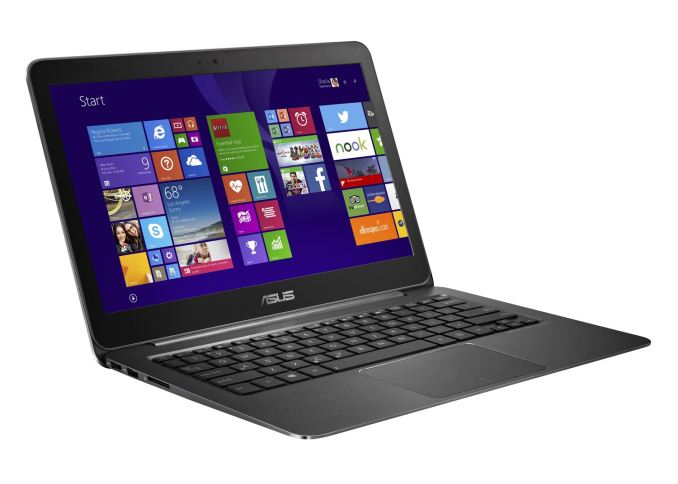








110 Comments
View All Comments
maxxbot - Wednesday, April 8, 2015 - link
If the device buyer's choice is between the Core M and an ARM or Atom they're going to go with the Core M because it's faster in every aspect, especially burst performance. If the Core M in unacceptable slow for you then there aren't any other options at the 4.5W TDP level to turn to, it's the best currently available.name99 - Wednesday, April 8, 2015 - link
That ("Maybe Intel made too many compromises") seems like the wrong lesson.I think a better lesson is that the Clayton Christensen wheel of reincarnation has turned yet again.
There was a time more than 40 years ago when creating a computer was a demanding enough exercise that the only companies that could do it well were integrated top to bottom, forced to do everything from designing the CPU to the OS to the languages that ran on it.
The PC exploded this model as standardized interfaces allowed different vendors to supply the BIOS, the OS, the CPU, the motherboard, the storage, etc.
BUT as we push harder and harder against fundamental physics and what we want the devices to do, the abstractions of these "interfaces" start to impose serious costs. It's no longer good enough to just slap parts together and assume that the whole will work acceptably. We have seen this in mobile, with a gradual thinning out of the field there; but we're poised to see the same thing in PCs (at least in very mobile PCs which, sadly for the OEMs, is the most dynamic part of the business).
This also suggests that Apple's advantage is just going to keep climbing. Even as they use Intel chips like everyone else, they have a lot more control over the whole package, from precisely tweaked OS dynamics to exquisitely machined bodies that are that much more effective in heat dissipation. (And it gets even worse if they decide to switch to their own CPU+GPU SoC for OSX.)
It's interesting, in this context, where the higher frequency 1.2GHz part is difficult for some vendors to handle, to realize that Apple is offering a (Apple-only?) 1.3/2.9GHz option which, presumably, they believe they have embodied in a case that can handle its peak thermals and get useful work out of the extra speed boost.
HakkaH - Friday, April 10, 2015 - link
Device buyers don't even see beyond the price tag, brand name and looks. 90% of the people who buy tech are pretty oblivious on what they are buying. So they wouldn't even know if a device would throttle the speed at all.Secondly I'd rather have a device that throttles good which processors are doing the last couple of years than have a steady pace at which it just crawls along and maybe after 5 minutes decides... hey maybe I can add 200 MHz and still be okay. If that is your case I bet you still have the first generation smartphone in your pocket instead of a more recent model because they all aggressively throttle the CPU and GPU in order to keep you from throwing your phone out of your hands ;)
HP - Saturday, August 8, 2015 - link
Your description doesn't follow the usage paradigm of most computing tasks. As the user is actively using their device what they do on the machine roughly tracks the user's thought patterns which largely takes place in series. He doesn't batch the tasks in his head first and then execute them. So race to sleep is where it's at.milkod2001 - Wednesday, April 8, 2015 - link
What about Intel's native 4 core mobile CPUs. Are any in the works?Core M,Y, U(2 core) etc might be OK for bloggers, content consumers etc but if one wants/needs real performance on the go, there's not that much new to offer, right?
nathanddrews - Wednesday, April 8, 2015 - link
I think we'll have to settle for the i7-4700 until Skylake. Not a bad place to settle.kpkp - Wednesday, April 8, 2015 - link
"Atom competed against high powered ARM SoCs and fit in that mini-PC/tablet to sub 10-inch 2-in-1 area either running Android, Windows RT or the full Windows 8.1 in many of the devices on the market."Atom in Windows RT? Wasn't RT ARM only?
Essence_of_War - Wednesday, April 8, 2015 - link
Very impressed by the Zenbook, especially at its price point.boblozano - Wednesday, April 8, 2015 - link
Thanks for the detailed article.In this space it's clear that the top design consideration is cooling - do that well, and everything else follows. Performance will be delivered by the SoC's ability to turbo as needed, power consumption by the SoC and the rest of the design.
Of course materials, size, the question of passive vs. active cooling ... all that also factors decisively into the success of a design, whether the target market actually buys the devices.
But the effectiveness of the cooling will largely determine performance.
Refuge - Wednesday, April 8, 2015 - link
The efficiency of the cooling too. Can't have it take up too much space or too much power (If active and not passive)otherwise you leave either no room for your battery, or you drain it too fast keeping the thing cool (In the case of active)